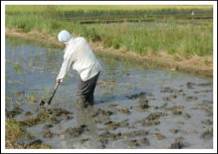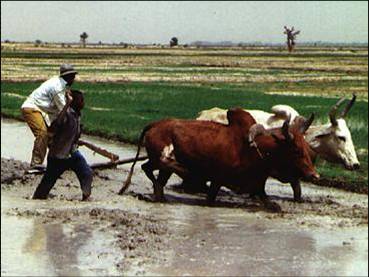|
|
|
Land preparation |
|
||||
|
|
|
|
|
||||
|
|
|
Types of farm power |
|
||||
|
|
|
|
|
||||
|
|
|
Describe and determine the different types of farm power. |
|
||||
|
|
|
Introduction
Farm power is one of the most expensive and critical inputs when growing a rice crop.
Humans, animals and machines are all used as sources of power in agriculture production. When undertaking different operations on a farm, a certain amount of work is required to complete the task.
When this work is undertaken over time, it is then called power. Power or the rate of doing work can be expressed as horsepower or Kilowatt. One horsepower is equivalent to 0.75 Kilowatt.
In the past much of the power used on farm came from human inputs but with much of the rural labor force now moved to cities, farmers are becoming more dependant on machines to complete tillage, planting and harvesting operations.
1. Human Power
In some instances manual labor is still more efficient than machine. Many countries are now suffering from rural labor shortages and have had to develop and use machines to complete tasks on time. One man is capable of shifting between 2-3m3 soil per day. In tillage terms that is equivalent to ploughing or tilling about 60m2 per day or it would take approximately 160 person-days to till 1 ha.
2. Animal power
The advantages of using animals include: • Cheap to maintain • Multi purpose use for meat and milk, • Self-replacement and • Manure production
Disadvantage of using animals include: • Animals have limited daily working hours • Animals need feeding and protection against pests and disease. • Slow • High man/power ratio • Limited range of working conditions • Animals require training
One animal takes 7-8 days to plough 1 hectare and cost up to $US 500 each.
3. Engine powered tractors
There are 3 broad groups of engine powered tractors used for rice production in Asia. These are 2 wheel tractors, 4 wheel tractors and track laying tractors.
Tractors are often the most expensive, sophisticated and potentially dangerous piece of equipment on a farm. Tractor operators must be familiar with the location and understand the operation of each control lever or button before attempting to start the tractor. |
|
||||
|
|
|||||||
Go online to see more info |
|
For more pictures and information on land levelling, please visit: http://www.knowledgebank.irri.org/farmPower/WebHelp/default.htm
|
|
||||
|
|
|
|
|
||||
Next lesson |
|
This lesson ends this module on land preparation. The next module talks about planting the rice. |
|
||||




